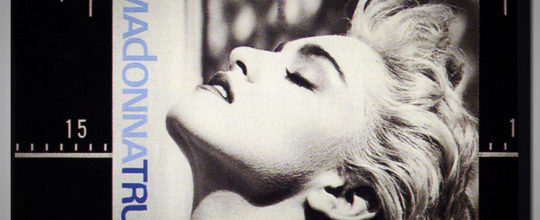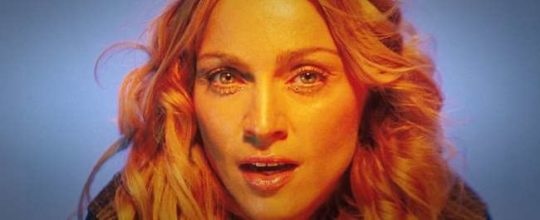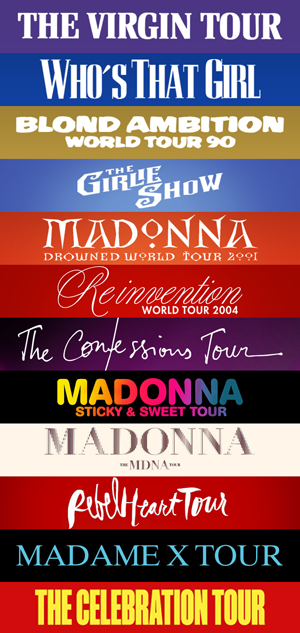Madonna’s “Ray of Light” collaborators look back
From RollingStone.com:
Twenty years ago, Madonna was at a crossroads. After launching her Maverick entertainment company in 1992 with her widely but not wisely panned Erotica album and Sex book, the star entered a period of relative caution. The exuberant queerness of those works gave way to muted ballads, followed by Evita, which made her feminism palatable to Middle America. After the birth of her daughter Lourdes in 1996, she sought spiritual enlightenment in Kabbalah and Ashtanga yoga, and immersed herself in the work of songwriters who shared their secrets via meditative electronic textures – particularly Björk, Everything But the Girl and Tricky.
All these factors shaped Ray of Light, an album akin to those artists’ work, but also uniquely Madonna-esque. Rooted in the underground yet heard and loved by millions, it’s the multi-platinum antecedent to today’s popular EDM, but considerably more personal. Twenty years later, singers and producers alike are still chasing its finely finessed fusion of anguished rumination and beat-driven bliss. Rolling Stone spoke with key collaborators on this watershed LP. Here are six things we learned.
1. Although the project’s synth-centric final results earned her the passing nickname Veronica Electronica, Madonna didn’t initially plan to work with songwriter Rick Nowels or producer William Orbit.
After Evita, Madonna reunited with Babyface, co-producer and co-writer of Bedtime Stories’ Take a Bow, which had topped the Hot 100 for seven weeks in 1995. But according to the smooth-soul magnate, “Madonna didn’t want or need to repeat herself.” Spotting her at Barney’s department store when he’d come to Manhattan for the Grammys, producer and songwriter Rick Nowels – now Lana Del Rey’s primary collaborator – impulsively introduced himself. “I told her I was nominated for a Grammy for Celine Dion’s Falling Into You,” he recalls. Much to his surprise, she replied, “Oh, I love that song.” This led to a meeting at her home, where, according to Nowels, “She said she had no idea what the new album was going to be.” At Nowels’ Mulholland Drive home studio, the pair wrote nine songs in 10 days.
“Until then, I had only written with friends – Ellen Shipley, Billy Steinberg, and Stevie Nicks,” Nowels remembers. “It was quite unnerving to write one-on-one with the biggest star on the planet. But I loved her songs and felt an emotional kinship with her music. I got a lot of DJ records and old film score records and prepared loops to write to. Once the song was written, we’d drop the loop and program our own beat. Little Star and The Power of Good-Bye were written over a drum ‘n’ bass rhythm, which was happening at the time. To Have and Not to Hold was written to a bossa nova beat.”
Guy Oseary – chairman of Maverick Records – phoned synth-pop veteran William Orbit, who’d previously remixed Madonna’s Justify My Love and Erotica. Orbit’s involvement expanded as the project evolved, although core Madonna associate Patrick Leonard and British producer Marius De Vries were both called in to assist as the album’s creation stretched out over four-and-a-half months – an eternity for the fast-working Madonna.
2. Ray of Light is largely about spiritual transformation, but one song deals with the perils of hard drugs.
Candy Perfume Girl came out of a two-week writing and recording stint between Orbit and Susannah Melvoin, daughter of top L.A. session musician Mike Melvoin, brother to late Smashing Pumpkins touring keyboardist Jonathan Melvoin, twin sister to Prince and the Revolution’s Wendy Melvoin, and former fiancée to Prince. She’s no slouch herself: As member of the Family, a splinter group of the Time, she co-sang the original version of Nothing Compares 2 U and co-wrote one of Prince’s sweetest songs, Sign o’ the Times’ Starfish and Coffee. According to Melvoin, William Orbit offered her some tracks to write melodies and lyrics to and sing over for what she thought would either become her solo debut or an album by Orbit’s Strange Cargo project, which she – and, it turns out, Madonna – both loved.
“I was on the floor [of Orbit’s studio], just putting words together, and came up with Candy Perfume Girl,” she recalls. “It was a personal track for me. At the time, I was mourning my brother [Jonathan died of a heroin overdose in 1996], and it was the allure of drug addiction. I was pretty jacked up about that record happening, and there were a couple of other songs that I had done with him there.”
But Melvoin’s publisher got a call notifying her that Orbit had offered Madonna the tracks they’d worked on: Candy Perfume Girl was going on the record, and Madonna wanted a third of the publishing. Melvoin maintains she also wrote the original lyrics to Ray of Light’s Swim, which, she says were “changed, but not significantly,” as well as the original melodies, which she concedes were “manipulated.” Yet in this case Melvoin didn’t get credit or compensation. The songwriter emphasizes she has no beef with Madonna; she feels the superstar understood exactly what Candy Perfume Girl was about, and that she made a brilliant record. “But had I gotten proper publishing on Ray of Light,” Melvoin asserts, “I wouldn’t be worried about my financial life.”
3. The album’s defining techno-rock title track was based on an obscure folk oldie.
Just as Orbit offered Madonna his Melvoin material, he similarly sent her a tape featuring unreleased work with Christine Leach, an English singer who’d co-written and sang with Strange Cargo. Leach’s uncle is David Atkins, who, as Dave Curtiss, had been half of Curtiss Maldoon, an overlooked folk duo that released a pair of unsuccessful albums on Deep Purple’s label in the early Seventies. The first one yielded Sepheryn, which Leach altered and sang parts of over the instrumental track given to her by Orbit, who had assumed Leach solely wrote what she sang. Madonna made additional changes, and the track became what we know as Ray of Light, which is credited to Madonna, William Orbit, Clive Maldoon, Dave Curtis [sic] and Christine Leach.
Some elements Ray of Light are strikingly similar to parts of Sepheryn: The opening vocal melody remains basically the same while the lyrics deviate only slightly. But Ray of Light omits the multiple tempo changes of Sepheryn while maintaining a steady rhythm. These changes appear in the Leach rendition leaked online. Madonna’s interpretation – which adds a crucial second, goddess-centric verse – is certainly closer to it than to the Curtis Maldoon original, but Madge’s way with the melody commands and sustains attention in ways that Leach’s does not. Madonna and Orbit managed to turn a compelling experiment in transformation into the cornerstone of a whole album about radical personal and spiritual growth.
4. Despite the borrowing, Madonna’s Ray of Light collaborators consider the icon to be a top-level musical mind.
Having co-written and co-produced significant chunks of many Madonna albums, including Ray of Light, as well as serving as her keyboardist and musical director on two major tours, Patrick Leonard has worked with Madonna longer and more extensively than any other musician. He also co-wrote and produced Leonard Cohen’s final three studio albums, so when he calls her “a helluva songwriter,” it means something.
“Her sensibility about melodic line – from the beginning of the verse to the end of the verse and how the verse and the chorus influence each other – is very deep,” he contends. “That’s not common. Say Live to Tell, for example, our first big single. The melodies I wrote are still there and she sings them for the most part, but it’s where she departs from them that turned it into a song. Many times she’s singing notes that no one would’ve thought of but her. Some of it can be perceived as naiveté because she’s picking a note you wouldn’t choose. But who needs the ‘correct’ note? You need the right note that tells the story, and she’s great at that. She certainly made me look better. All I have to do is look at all the other people I wrote with over the years and how that went.”
Los Angeles-based cellist Suzie Katayama has worked with many big names in rock and pop including Roy Orbison, Neil Young, Prince, Eric Clapton, Björk and Beck. Her association with Madonna goes way back to 1986, and for Ray of Light, she conducted its strings and woodwinds – 20 violins, six violas, six cellos, four basses, two flutes and an oboe.
“It was a long day,” she recalls. “For that album, we did the orchestra in one day, both Frozen and The Power of Good-bye. That’s why I don’t remember much except for working really hard and fast. Everything that Madonna does, she is there. I have never been to anything that’s hers that she didn’t have the final say on it. She’s hands-on. People can say whatever they want, but I remember when she did Dick Tracy, I had never seen anyone work so hard. I was impressed, and I think everyone was because she had to hold her own with a lot of people in that movie.
“This was the record where I had more people calling me, saying, ‘Whoa, this is a great record,'” she continues. “It was real musical. Ray of Light showed a side of her that I don’t think most people saw.”
5. One of the songs written but not recorded for Ray of Light was released years later by an Italian superstar.
If you’re not European or don’t listen to Spanish-language radio, you probably don’t recognize the name Laura Pausini. But the Faenza-born singer is pretty much a household name overseas, having sold more than 70 million records internationally. Her attempt to crack the U.S. market, 2002’s From the Inside, flopped spectacularly. So for 2004’s Resta in Ascolto and its equivalent Escucha, Pausini returned to Italian and Spanish respectively, and together those albums sold more than 5 million copies, while the latter snagged both Grammy and Latin Grammy trophies. According to Nowels, their closing song, Mi Abbandono a Te (Me Abandono a Ti on Escucha) was originally titled Like a Flower, and was composed by both him and Madonna during their Ray of Light songwriting sessions. Having re-written most of the Nowels-produced ballad’s lyrics in Italian and Spanish, Pausini makes it her own. Nevertheless, the melody’s melancholy Ray of Light–ness remains: The bilingual chorus couldn’t be more Madonna if it poked you in the eye with a pointy bustier.
6. None of Madonna’s records won a Grammy until Ray of Light.
The Recording Academy often rewards entertainers who release hit after hit, but this hasn’t been the case with Madonna for much of her long career. In her first 15 years of releasing albums, she got a few scattered Grammy nominations – including nods for Crazy for You, Papa Don’t Preach, and Who’s That Girl – but her only win was for Blond Ambition World Tour Live, a long-out-of-print 1990 laser disc that’s never been officially reissued on DVD or any other format.
But Ray of Light significantly interrupted her losing streak: It won for Best Dance Recording and Best Pop Album, and the title track’s promo clip won Best Short Form Music Video. Since then, she’s won three more times out of 15 subsequent nominations – including Best Electronic/Dance Album for her 2005 LP Confessions on a Dance Floor, which features a kindred mix of rhythmic extroversion and poetic reflection.
Rather than throwing the Academy some deserved shade, Madonna, taking the stage in a flaming red Jean-Paul Gaultier kimono, merely thanked her collaborators before she yanked William Orbit – who towered shyly above her – down and toward the mic, chiding him for mumbling his gratitude: “He does speak English; you’d never know it.”







